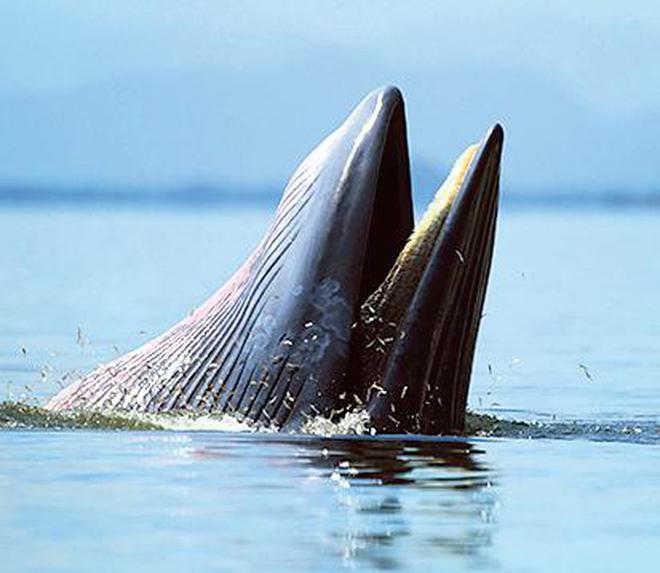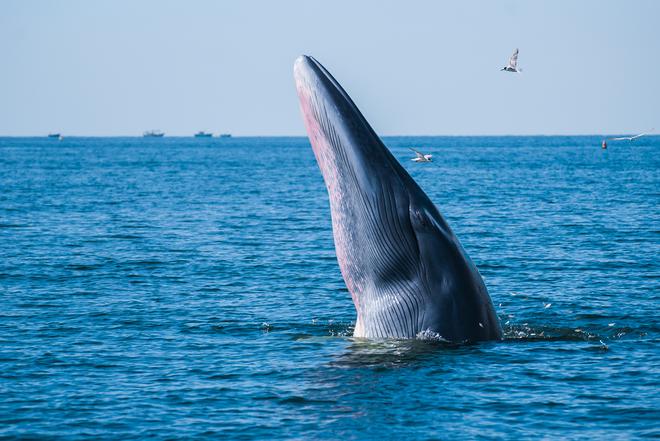It was a bright sunny day on July 27 at Pathameghavaram village in Srikakulam district of Andhra Pradesh. Fishermen had just returned from sea when they noticed something massive glistening on the shore. On closer look, they found that it was a huge marine creature, almost the size of four boats put together, washed ashore dead. Word spread like wild fire and soon the beach was teeming with people who gathered to take a look at the peculiar species. Videos and images went viral on social media with many claiming it to be a blue whale.
A day later, Visakhapatnam-based East Coast Conservation Team (ECCT) along with veterinarians and officials of AP Forest Department identified the species as a Bryde’s whale, 10.06 metres in length and weighing about five tonnes. The team collected morphometric data on the marine animal to learn of any abnormality. According to the officials, this is said to be the first such record of a Bryde’s whale on the coast of Andhra Pradesh. A necropsy done on the specimen by Visakhapatnam zoo veterinarian Phaneendra Andra revealed an empty stomach and intestines that suggest death by starvation. The report also brought to light several marks of stress from ropes on the body, indicating entanglement in ropes from a ghost net or other types of nets.
The incident has baffled marine biologists and researchers as beaching of whales is rare in this part of the coast. “It was a peculiar and sad sight. The marine animal looked thinner than its usual size. It was a sub-adult male, expected to be around eight to 10 years of age,” says Dr Phaneendra, adding that normally, sub-adult whales remain in pods.

Bryde’s whales are common among other baleen whales in Bay of Bengal. The largest Bryde’s whale is almost half the size of a fully grown blue whale. It can grow up to 14 to 16 metres long. Occurring in warm temperate and tropical waters, the Bryde’s whale usually appear individually (adults) or in pairs, and occasionally in loose aggregations of up to 20 animals around feeding areas. These species are seen to be more active on the water surface, especially in coastal waters. The Bryde’s whale (Balaenoptera edeni) is listed in Convention on International Trade in Endangered Species of Wild Fauna and Flora (CITES) Appendix I, which prohibits commercial international trade.
According to marine biologist Sri Chakra Pranav Tamarapalli, founder of ECCT, there was high possibility that the whale was still dependent on its mother or the pod for feeding. “Separation from mother could be a reason for starvation. The multiple marks on its body is likely due to the net entanglement. The animal might have been separated from the pod as a result of this. If it was a trawl net, it could have dragged the marine animal away from its mother for several kilometres resulting in separation. It is also likely that a ghost net could have restricted its movement or closed its mouth.,” says Pranav.

Ghost nets (nets that are damaged while fishing and abandoned in the ocean) are a source of 70% plastic in oceans. These pose a grave threat to marine life with increasing incidents of entanglement of fish, turtles, sharks, dolphins and whales being reported across the Indian coast, killing lakhs of marine life every year.
Another theory suggests that presence of cold oceanic currents towards the land are possible reasons behind beaching of whales. However, in the case of Bryde’s whale (Balaenoptera edeni) this may not be true, say marine biologists.
Unrecorded incidents of beaching of whales are reported from some parts of Tamil Nadu coast as well. Theories abound for why beaching occurs, but marine researchers are still looking for answers.







